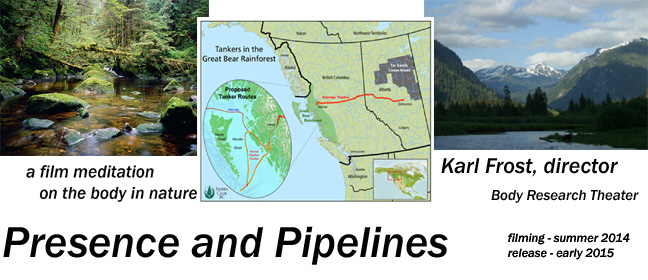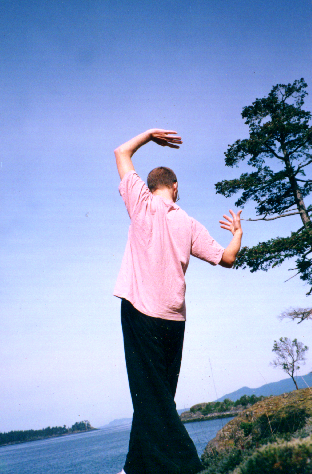Presence and Pipelines Film
a film meditation on the sensory connection to the more-than-human world and the effects of unhurried being in nature on the mind and body.
directed by Karl Frost, with collaborators Leslie Castellano, Isabelle Kirouac, Willoughby Arevalo, Eliot LeFiend, Emma Garrod, and others.
The explorations of the film will be situated in places in British Columbia currently threatened by expansion of the fossil fuel industry and proposed Tar Sands Oil and Fracked Gas pipelines to coastal BC and the resulting expansions in dangerous tanker traffic: a time bomb guaranteed to devastate a remote part of the planet with one of the biologically richest ecosystems in the world. The exact locations of the filming are still being arranged, but current plans are to film in areas around Kitamaat, Smithers, Bella Bella, and Haid Gwaii, territories traditionally governed by the Haisla, Wet’suwet’en, Heiltsuk, and Haida First Nations.
- the primary film: a feature length art film that is the extension of the work started with Accidental Tourists, that will have a limited run of independent showings and which will be submitted to arts film festivals.
- a short film that will be a mixture of the art film and a traditional environmental short giving more of a straightforward exposition of the environmental issues, First Nations history, and potentially devastating impacts to the natural systems there from pipelines expansion. This film will aim for distribution via environmental film festivals and the internet.
While we expect a certain kind of deeper embodied impact from the feature length film, we also recognize that it will likely have limited distribution and access and so intend the short to be able to get to a wider audience for a broader political impact.
As an extension of the process begun with Accidental Tourists, the film is structured to allow for an embodied experience of the filmed locations through simple rules of filming which minimize the manipulative aspects of film work and provide space for a contemplation of experiences of spaciousness in place. It is this specific aspect of nature experience that we hope to capture in the film: the opening up of the senses that happens in prolonged time in places less marked by the human. Rules of filming and editing include: Simple Actions, No Acting, No Words, Simple Camera, Calm Editing, and No Added Sound. Click here for more information on the philosophy, structure, and filming/editing rules of the film.
This film is being funded in part through a successful Kickstarter campaign and in part through a National Science Foundation grant in support of director Karl Frost’s academic research on the effects of physical practice on environmental values and altruism.
The Politics of the Pipelines
The Great Bear rainforest stretches for more than 250 miles along the Coast of British Columbia, from a couple of hours north of Vancouver to the southern edge of Alaska. At 21 million acres, it is part of the largest remaining coastal temperate rainforest on Earth, a land where misty valleys meet glacier cut-fjords, mountains, old growth forests, and rich salmon streams. It is the home of western red cedar, hemlock, and spruce… Whales, wolves, and bears, and to First Nations and other communities that have been living off of the rich local natural resources for centuries
In 2006, a major ferry crashed just off Gil Island due to a moment of human error in a treacherous channel. Local Gitga’at First Nation fishermen came to the rescue and saved 100 passengers, but the Gitga’at are now left with a slow leak of 10s of thousands of gallons of diesel fuel into their fishing territory from the sunken ferry. This disaster is nothing compared to the inevitable disasters that would accompany the unavoidable oil tanker crashes in what is now an ecologically protected zone. If oil tankers are allowed into these dangerous channels, it is not a question of if the crash will happen, but when. The tankers that would come through this channel would be over 4 times larger than anything that has attempted to navigate these waters before, and these channels are known to be some of the most treacherous in the world.
The Exxon Valdez tanker disaster in Alaska spilled less than 1/10th of the oil as the Deepwater Horizon accident in the Gulf Mexico, and yet it had over 20 times the wildlife kill. This is a measure of the incredible biological fecundity of this place, which has supported one of the richest and most productive fisheries in the world. All of this is at risk from a single tanker accident. Hundreds of tankers are proposed to move through this area every year.
Then, there is the issue of the pipelines themselves. The pipelines companies, like Enbridge and Pacific Trails, claim that their pipelines will be safe, but these very same companies are producing disaster after disaster with their existing pipelines. a quick google search will turn up a horrifying number of news stories around North America about oil spills coming out of the Tar Sands project. Enbridge has been rejected by the people of BC, but the people of Kitimat who have the most to benefit in terms of the few permenant jobs that would be generated, and by First Nations groups across its route. The Harper government and BC provincial government are still trying to bring it back, and there are still over a half dozen ther piplelines that are being pushed through for lack of public awareness.
There is no reason that this should go through.
Then, there is the Tar Sands Oil Project itself. The movement of the oil is a massive ecological threat, but the production of the oil is itself an unmitigated disaster. There are copious resources on the web about this mindbogglingly disaster, so I will just refer you to them. We have to stop the expansion of the Tar Sands Project.
The environmental issues are in a critical moment, with the conservative Harper government trying to ram through this corporate boondoggle before resistance can reach critical mass. We want to help that critical mass happen. There is hope.
We are very excited to be engaged in this project. We think that the project will be meaningful as an art project with wider relevance, but we also hope that we will be able to have some meaningful impact by doing it in this amazing place, in this critical moment.
We hope with this film project to be contributing constructively the situation by bringing greater awareness of the issues and to this remote but very important part of our planet. By focusing on an experience of the place, we hope to faclitate the kind of emotional connection to place that will help generate the political will to stay involved in the issue.

